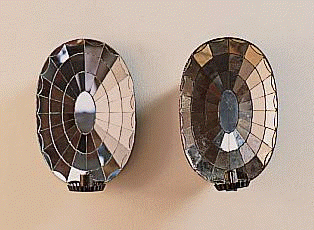Sconces

|
 Whether primitive or
sophisticated, early candle sconces are
difficult to date. The variety of forms
seems inexhaustible, and they owe as much
to the imagination of their makers as to
the general fashion of the times. Whether primitive or
sophisticated, early candle sconces are
difficult to date. The variety of forms
seems inexhaustible, and they owe as much
to the imagination of their makers as to
the general fashion of the times.
|

|

|
 Sconces offer unique decorative
flexibility. They provide much needed
sources of light as well as aesthetic
beauty to wall areas and room locations
often forgotten or ignored. Because of the
variety of shapes used by our forebears,
do not hesitate to mix a selection of
forms. However, keep in mind that sconces
were often used in pairs to satisfy the
early taste for symmetry in interior
design. Sconces offer unique decorative
flexibility. They provide much needed
sources of light as well as aesthetic
beauty to wall areas and room locations
often forgotten or ignored. Because of the
variety of shapes used by our forebears,
do not hesitate to mix a selection of
forms. However, keep in mind that sconces
were often used in pairs to satisfy the
early taste for symmetry in interior
design.
|
|
 Generally circular sconces with
bracket arms tend towards the early period
(17th and 18th centuries). Those sconces
with drip pans on protruding arms, by far
the rarer specimens, can be used
effectively in providing light to a
mirror, such as in a dressing room. It is
not advisable to select these shapes for
narrow passages, such as
hallways. Generally circular sconces with
bracket arms tend towards the early period
(17th and 18th centuries). Those sconces
with drip pans on protruding arms, by far
the rarer specimens, can be used
effectively in providing light to a
mirror, such as in a dressing room. It is
not advisable to select these shapes for
narrow passages, such as
hallways.
|

|

|
 Oval
sconces date to the middle period (late
1700's) and rectangular date to the early
19th century. The evolution of these
shapes followed improvements in candle
making. The increased lengths of later
sconces, which sometimes incorporate
reflectors and heat shields, accommodated
longer, slower burning candles. Sconces
were often hung from a wrought nail or
mounted on a simple wall bracket at about
eye level. Readily moved or relocated,
they can easily be incorporated into any
future decorating decisions with out
losing value, usefulness, or
appeal. Oval
sconces date to the middle period (late
1700's) and rectangular date to the early
19th century. The evolution of these
shapes followed improvements in candle
making. The increased lengths of later
sconces, which sometimes incorporate
reflectors and heat shields, accommodated
longer, slower burning candles. Sconces
were often hung from a wrought nail or
mounted on a simple wall bracket at about
eye level. Readily moved or relocated,
they can easily be incorporated into any
future decorating decisions with out
losing value, usefulness, or
appeal.
|
 PLF
Reproduction
PLF
Reproduction  Deerfield
Original Deerfield
Original
|
|